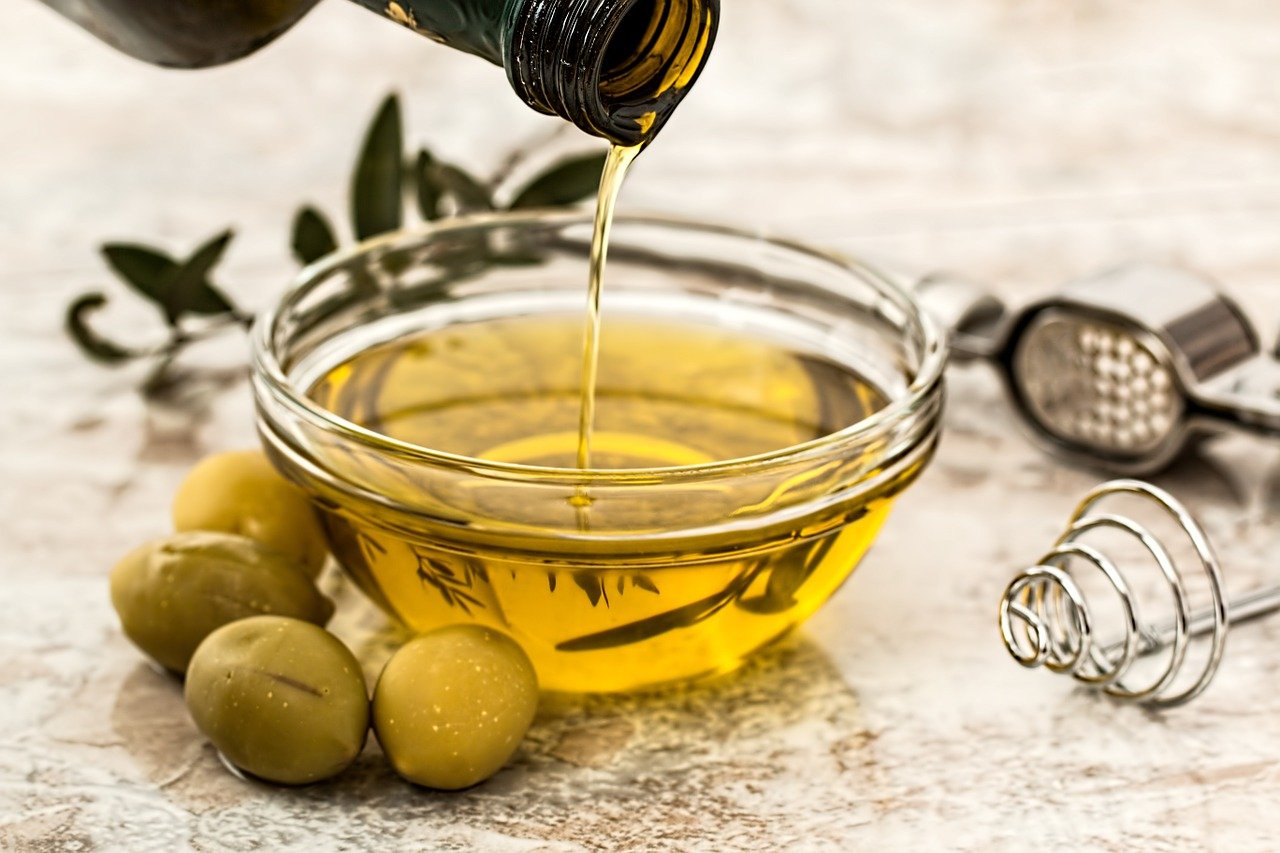Extra Virgin Olive Oil (EVOO) is pure olive juice passionately referred to over thousands of years as “liquid gold” and it is a healthy fat obtained from the olive, a traditional Mediterranean tree crop of the Mediterranean Basin. EVOO is produced by pressing whole olives picked during an early harvest (first and second harvest) usually occurring around the first full moon in late November and/or early December into February depending on the annual climate leading up to the harvest period in the Northern Hemisphere. In the Southern Hemispheric producing countries of Australia, Chile and Argentina this harvest would occur around July. EVOO is commonly used in the Mediterranean diet.
EVOO is extracted by first pressing semi-ripened olives of the flavorful, monounsaturated oil. The flavor, color and fragrance of olive oils can vary dramatically depending on distinctions such as the annual climate, the cultivar (varietal), growing region and the crop’s condition. EVOO can range from a crystalline champagne color to greenish-golden to bright green. In general, the deeper the color, the more intense the olive flavor. EVOO is graded in accordance with the degree of acidity they contain. EVOO is cold-pressed at less than 86°F (30°C) by mechanical means, within a chemical-free process that involves only pressure and no solvents nor heat thus producing natural levels of low acidity. For the EVOO, the cold-pressed result of the first pressing of the olives is less than 0.8 grams acidity (oleic acid) per 100 grams or 0.80%. It is considered the finest and fruitiest of the olive oils and is therefore also the most expensive do to the nature of selected picking and processing. It should have no defects and the flavor of fresh olives.
After extra virgin, olive oils are classified in order of ascending acidity. Virgin olive oil is also a first-press oil; however, the olive fruit is picked later at maximum maturation for maximum yield providing a higher oil yield with a higher level of acidity not more than 2 grams per 100 grams or 2%.
The “extra virgin” designation will only apply once the olive oil undergoes an International Olive Council (IOC) recognized official chemical test in an approved laboratory and a sensory evaluation by an IOC recognized trained tasting panel. For olive oil to be designated as EVOO, it must be found to be free from defects while exhibiting tastes of bitterness, fruitiness and pungency which is the peppery sensation in the mouth and throat associated with EVOO. All Olivar Santamaria Picual EVOO is guaranteed “extra virgin” and all analytics are provided by an authorized laboratory of the Consejeria de Agricultura y Pesca of Spain.
Picual Olive
Picual is an olive fruit varietal grown primarily in Spain in the Province of Jaén and the Region of Andalucía over an area of about 645,000 hectares (1.6 million acres). Picual olives are the most commonly grown olives for olive oil production with approximately 25% of the total olive oil production in the world and approximately 50% of the total olive oil production of Spain.
Olivar Santamaria Extra Virgin Olive Oil from Picual olives have some of the highest levels of polyphenols, an organic compound which is known to have antioxidant effects. Less than one quarter of the Picual harvest each year qualifies as EVOO as Picual groves are primarily harvested when ripe or overripe to maximize oil content and yield. The excellence of the EVOO it produces is due to the fatty acid content and the antioxidants. Picual EVOO usually contains 0 Defects, Acidity <0.80%, Oleic Acid 55 – 83%, Peroxides (meg O2 / Kg) <20, Polyphenols 100 – 500+, UV Absorption K-270 of <0.22. Olivar Santamaria Picual EVOO analytics on average possesses approximate 0 Defects, Acidity of <0.20%, Oleic Acid of 80%, Peroxides (meg O2 / Kg) of 5.4, Polyphenols of 500+, UV Absorption K-270 of <.10 and High Smoke Point of 405 ? F. These analytics are available from Khayyan LLC upon request.
The Picual oils of low-lying lands tend to have more body, with a slightly bitter taste and a hint of wood, while the Picual olives cultivated in the mountain regions tend to be sweeter, with a fresh flavor. Olivar Santamaria Picual EVOO gets its edge from the harsh climate of the beautiful central Spain region where grown. Picual derives its name from its pointed tip (pico). The olive is medium weighing approximately 3.2 grams. Maturation takes place between the beginning of November and mid-Janaury and the oil yield is considered high, reaching about 27%. Picual has a medium body, smooth texture, and sweet, buttery taste, but it finishes with a “peppery kick” given the polyphenol count that gives it an extra layer of flavor.
The more peppery kick and bitterness the healthier. Olivar Santamaria EVOO is an excellent choice for use as an everyday olive oil. As an all-purpose oil, Olivar Santamaria works beautifully in sauces and salads, and is a delicious counterpart to flavorful lemons and vinegars. For an appetizer, sprinkle it with assorted grated cheeses and spices and use it as a dipper for your favorite breads. When warmed, Olivar Santamaria EVOO gives off the aromas of green fruit, green grass, tomato, almond and notes of flowers, chamomile. Taste exhibits abundant fruitiness, green leaves, sweetness, bitterness, vigorous pungency and notes of artichokes, exotic fruits, almond, with exceptional harmony, a high complexity and a high persistence with that slight peppery finish.
Polyphenols
Polyphenols are antioxidants found in a variety of foods particularly in Extra Virgin Olive Oils (EVOO). Polyphenols such as Oleuropein, Oleocanthal, and hydroxytyrosol demonstrate intense flavors connected with pepper, bitterness and other desirable flavors characteristics of EVOO. The Picual olive fruit variety tends to exhibit the highest polyphenol count in the olive fruit universe. Recent studies indicate that these potent phenols are responsible for many of the health benefits associated with consuming fresh, high quality EVOO. Phenols in olive oil decrease over time or when exposed to heat, oxygen and light.
Consuming fresh, optimally produced EVOO with high polyphenol content is crucial when looking to obtain the maximum health benefit commonly associated with consuming EVOO.
Not All Extra Virgin Olive Oil is Created Equal
Varietal
The variety of olive fruit used to produce the oil determines the polyphenol count of the oil itself. For example, Picual olives have a very high polyphenol count and Arbequina have a very low count.
Time of Picking
Oil produced from unripe (green) olives will be richer in polyphenols compared to oil produced from the same olives that have been allowed to reach maturity.
Environmental Factors
The annual climate, altitude, irrigation and cultivation have an impact on polyphenol counts.
Extraction Conditions
Polyphenols are lost when techniques meant to enhance yield are utilized, such as adding water, heating the paste and increasing malaxation time.
Storage Containers
The longer an oil sits the less polyphenols it will have. Storing the olive oil in the right container will extend the oil’s life and keep the polyphenols from oxidizing too quickly.
In general, polyphenols are substances that are found in many plants and provide some flowers, fruits, and vegetables their color. Polyphenols have antioxidant activity that protect cells from the damage caused by free radicals (unstable molecules made by the process of oxidation during normal metabolism). Free radicals may play a part in cancer, heart disease, stroke, and other diseases of aging. Antioxidants include beta-carotene, lycopene, vitamins A, C, and E, and other natural and manufactured substances. Olive oil is a natural fruit juice with an average shelf life of approximately 9-15 months from the date of pressing. Higher quality EVOO with high polyphenol counts and high oleic acid counts will last longer, approximately 23 months, if stored in a dark environment at room temperature.
Extra Virgin Olive Oil Health Benefits
Khayyan Picual and Hojiblanca variety derived extra virgin olive oils are some of the healthiest one can consume, packing a serious array of nutrients and vitamins for a healthy diet. Over the years much research has been conducted around the health benefits of Extra Virgin Olive Oil (EVOO). Below , you will find some of the benefits research have found.
Research Findings
Heart Disease
Heart disease is the most common cause of death in the world. Studies conducted over the past few decades showed that heart disease was rare around the Mediterranean Sea. The Mediterranean diet has now been shown to significantly reduce the risk of heart disease and as EVOO is a main component of this diet studies have shown that consumption of EVOO can protect against heart disease via numerous mechanisms such as lowering of inflammation, protects LDL cholesterol from oxidation, improves the function of the lining of blood vessels, may prevent blood clotting and lower blood pressure.
Cancer
Cancer is one of the most common causes of death in the world. People in Mediterranean countries have a lower risk of some cancers, and many researchers believe that EVOO may have something to do with it. The antioxidants in EVOO can reduce oxidative damage due to free radicals, which is believed to be one of the leading drivers of cancer and studies have shown that compounds such as polyphenols in olive oil can help fight cancer cells.
Type 2 Diabetes
Extra Virgin Olive Oil appears to be highly protective against diabetes. Several studies have linked olive oil to beneficial effects on blood sugar and insulin sensitivity. A randomized clinical trial of 418 non-diabetic participants recently confirmed the protective effects of EVOO. In this study, a Mediterranean diet with EVOO reduced the risk of developing type 2 diabetes by over 40%.
Rheumatoid Arthritis
Rheumatoid arthritis is an autoimmune disease characterized by deformed and painful joints. The exact cause is not well understood, but it involves the body’s immune system attacking normal cells by mistake. EVOO use in diet appears to improve inflammatory markers and reduce oxidative stress in individuals with rheumatoid arthritis. Olive oil appears to be particularly beneficial when combined with fish oil, a source of anti-inflammatory omega-3 fatty acids. In one study, EVOO and fish oil significantly reduced joint pain, handgrip strength and morning stiffness in people with rheumatoid arthritis.
Analytics
OLIVAR SANTAMARIA EXTRA VIRGIN OLIVE OIL

From Vine to Wine to Vinegar
Solera wine vinegars, one of the most sophisticated perfumes in the world of gastronomy, are considered amongst the finest ingredients providing chefs, home cooks, culinary experts and modern-day Speakeasy-style bar men and women with a wide array of flavors for cooking and mixing cocktails.
Unique wines aged into exceptional vinegars provide kitchens around the world with a wide range of possibilities to demonstrate exquisite culinary creations involving menus of a traditional kind to the most modern and avant-garde.
Originally referred to wine vinegars as “sour wines” (vinum acre) by the Romans, (consumed by lesser beings), these vinegars became a staple ingredient for both drink and food creation for the Spanish peasantry over many centuries. These wine vinegars’ unique diversity is derived from the range of diverse regional grape varieties and wine quality in western Andalusia, Spain spanning from the historic regions of south Córdoba province to the Jerez region. The unique aging techniques display distinctive flavors and characteristics for culinary experts and bartenders, alike, to explore, utilize and have fun with.
Since the mid twentieth century, winemakers started to view solera wine vinegar as a prized product and began to carefully age their vinegars in the same way as their wines and brandies in bodegas. Thus, the recent release of exquisite 50-year Pedro Ximenez balsamic wine vinegars from throughout the region especially under PDO Vinagre de Montilla-Moriles designation.
Barrels containing vinegar are always quickly removed from the wine bodega, this is to prevent other barrels of wine also turning to vinegar. Any barrels which have contained vinegar cannot be used to store wine again due to the risk of acetic fermentation. In the past the vinegar was given away to staff and family of the owner or sold at the bodega (wine cellar) door. Some barrels were stored separately and often forgotten about. These vinegars, many 50 years in the making, are now being released and re-discovered.
Spain’s wine vinegar industry prides itself on picking aperitif wine quality Fino, Oloroso, Moscatel or Pedro Ximenez wine denominations, particularly, in the Córdoba region under the lesser known yet highly respected PDO Vinagre de Montilla-Moriles with traditional wine making maturation techniques – the solera system. However, instead of the wine getting fortified, it is fermented further for a minimum of six months up to several decades, with bacteria, converting alcohol into acetic acid during which fermentation process the vinegar adopts the aged oak barrel flavors and aromas along with delicate pale golden (Fino), amber / mahogany (Oloroso), topaz (Moscatel) and ebony (Pedro Ximenez) colors depending on the amount of oxidation. As solera wines, their derived vinegars are also protected by Denomination of Origin per regions such as PDO Vinagre de Jerez, PDO Vinagre de Condado de Huelva and the earlier discussed PDO Vinagre de Montilla-Moriles.
The highly coveted Montilla-Moriles denomination of origin wine vinegars exhibit semi-sweet, sharp-dry or sweet-and-sour flavor vinegars reflecting this area’s longstanding tradition of Fino, Oloroso, Moscatel and Pedro Ximénez (PX) wines. Located in southern Córdoba in the Andalusian region, more than three-quarters of the region’s vines are PX. Of course, not all wines are sweet; there are also a wide range of grape varieties that include finos, amontillados and olorosos, and these same types of wine are reflected in the region’s vinegars.
The vinegars are aged in criaderas and solera, or as añadas. Most commonly, the solera technique used involves an acetic fermentation of high quality wine destined to become vinegar. In American Oak barrels, the wine is treated with a mother culture from an older batch of vinegar, which barrels rest on top of three or more rows of barrels, slowly facilitating the conversion of alcohol into vinegar. During bottling, producers will take vinegar from their most mature barrels on the bottom row without draining them completely. That empty space will then be filled with younger vinegar from another barrel, and then that barrel may then be filled with even younger wine, back on top of the several stacked rows. This delicate process masterfully repeats year after year, so each bottle contains small amounts of very mature vinegar that mixes with newer vintages of wine vinegar.
As in the other wine vinegar regions, PDO Vinagre de Montilla-Moriles boasts several different vinegar categories based on the type and length of aging: Añada (minimum 3 years in a single oak barrel), Crianza (6 months), Reserva (2 years) and Gran Reserva (minimum 10 years). Additionally, these wine vinegars may be classified by their sweetness and grape varieties which classifications are dependent on the adding of additional concentrated juice from freshly mashed grapes or a small amount of sweet PX wine. Thus, the resulting wine vinegars exhibit pale golden (Fino), amber / mahogany (Oloroso), topaz (Moscatel) and ebony (Pedro Ximenez) colors with velvety liquids that give off a rich hint of diverse flavors with delicate sour notes for an elegant finish.
Although this region was recently granted its Designation of Origin status in 2008, vinegars from PDO Montilla-Moriles have already made a name for themselves throughout the world and Khayyan Specialty Foods is pleased to be part of the introduction of these unique flavors to America and the rest of the world.




